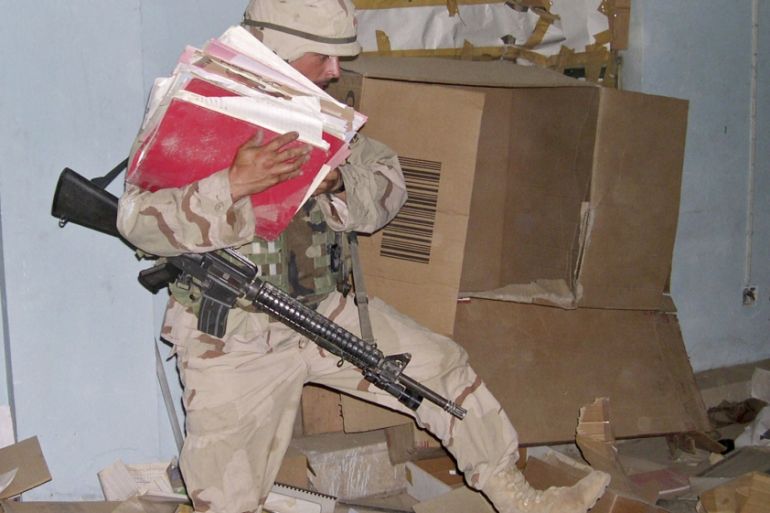How the NYT partook in the plunder of Iraq
Who gave permission to the New York Times to remove thousands of ISIL files from Iraq?

Many of the precious objects displayed in the global north’s major museums were plundered from their home in the global south. The dubious itinerary and the illegal and unethical practices that facilitated the plunder cannot be found in the laconic texts accompanying these exhibited objects.
The narratives that frame the objects and collections and erase the plunder are usually those of “saving” and “recovering”. Oceans away from their homeland, these treasures are often represented as being more “at home” in their exile in these metropolitan centres of the global north. They are “safe and sound” here and housed in reputable institutions where scholars and experts, who appreciate and understand their value and history, tend to them and curate popular and very profitable exhibits for the benefit of metropolitan audiences. As if the natives, the rightful owners of these objects, do not deserve them.
Keep reading
list of 4 itemsWall Street Journal cuts Hong Kong staff, shifts focus to Singapore
Abu Dhabi-backed group ends bid to take over Telegraph newspaper
Two Russian journalists arrested over alleged work for Navalny group
Some governments in the global south have been lobbying for years to retrieve some of these cultural treasures, but the process is not so easy and the balance of power is skewed. The tragic irony is that these plundered treasures are at times “loaned” back to their rightful owners in countries of origin.
The practise of plunder extends beyond archeological treasures and pre-modern relics. Entire archives and collections of important documents are still plundered by foreign institutions (or individuals working with them) and states.
Iraq is the most salient example, particularly after the Anglo-American invasion of 2003. The United States plundered millions of documents and moved them out of Iraq during its occupation of the country. With the exception of the Iraqi Jewish Archive, which is set to be returned to Iraq in two years, there are no plans to return any of the other collections.
In fact, in the past two years, more documents have been removed from the country, continuing this decades-long plunder. In a recent piece, the New York Times bragged about taking to the US thousands of ISIL documents its journalists snatched from liberated areas in Iraq.
Perhaps one should not be surprised that the newspaper that participated in justifying the 2003 invasion of Iraq does not consider these actions unethical.
A history of plunder
I have written before about the Bath Party Archive (consisting of three million pages) which was plundered by Kanan Makiya, who supported the 2003 invasion, and his Iraq Memory Foundation, which, despite its name, is a Washington-based organisation with no actual presence in Iraq outside the heavily guarded and privileged Green Zone of Baghdad.
In 2005, the US army helped Makiya ship the documents to the US. Despite calls from Saad Eskander, the then Director General of Iraq’s National Library and Archive, to return these documents to Iraq, the Iraq Memory Foundation decided otherwise.
In January 2008, the foundation signed an agreement with the Hoover Institution to transfer the documents there. Three months later, the Society of American Archivist (SAA) and the Association of Canadian Archivists (ACA), the world’s largest organisation of archivists , wrote in a statement of its “deep concern about [these] records and others obtained by the United States … in actions [that] may be considered an act of pillage, which is specifically forbidden by the 1907 Hague Convention.”
The letter stressed that these records must be returned to Iraq “to be maintained as part of the official records in the National Library and Archives.” But this plundered archive was not returned and sits at the Hoover Institution to this day. Iraqi citizens and Iraqi scholars have no access to this important collection.
‘The ISIS files’
The most recent episode of plunder comes courtesy of the New York Times. On April 4, Rukmini Callimachi, a correspondent for the paper who has been covering the Islamic State of Iraq and the Levant (ISIL, also known as ISIS) and was embedded with Iraqi military units, published a piece called The ISIS files. The piece describes how Callimachi and her team took thousands of ISIL documents that were left behind after its forces were pushed out.
“On five trips to battle-scarred Iraq, journalists for The New York Times scoured old Islamic State offices, gathering thousands of files abandoned by the militants as their ‘caliphate’ crumbled,” the article claims.
Callimachi writes that Iraqi security forces “led the way and gave permission to take the documents”. However, there is no record, oral or written, of any official permission from the Iraqi army or defence ministry to give these documents away.
The documents are crucial for the country’s history and its future and they belong to the Iraqis. Their removal from Iraq, irrespective of any justification, is a violation of the 1907 Hague Convention.
Iraqis across areas formerly held by ISIL are struggling to rebuild their destroyed cities and to reconstruct their shattered lives. Why have they been deprived of troves of documents containing evidence of crimes committed against them?
It is noteworthy and ironic that the NYT inserted the following into the “ISIS files” story under the heading “Sharing the records”:
“The New York Times is working to make the trove of ISIS documents publicly available to researchers, scholars, Iraqi officials and anyone else looking to better understand the Islamic State.”
How generous of them!
The views expressed in this article are the author’s own and do not necessarily reflect Al Jazeera’s editorial stance.
